Brand Communication and Reputation Management: Case Studies
VerifiedAdded on 2020/10/05
|14
|3919
|234
Report
AI Summary
This report delves into the critical aspects of brand communication and reputation management, emphasizing the role of public relations (PR) in maintaining a positive brand image and navigating crises. It examines two prominent case studies: Facebook and Tesco, both of which have faced significant PR challenges. The Facebook case study analyzes the Cambridge Analytica scandal, exploring the impact on user data privacy, the company's response, and the role of media and crisis communication theories like the Situational Crisis Communication Theory (SCCT) and stakeholder theory. The Tesco case study focuses on the company's delayed payments to suppliers. The report assesses how these companies handled their respective crises, the effectiveness of their PR strategies, and the application of relevant theoretical frameworks. The analysis covers the actions taken by each company, the media's influence, and the importance of proactive crisis management in protecting brand reputation and stakeholder relationships. The report concludes with an assessment of the strengths and weaknesses of each company's approach and provides insights into best practices for brand communication and reputation management.
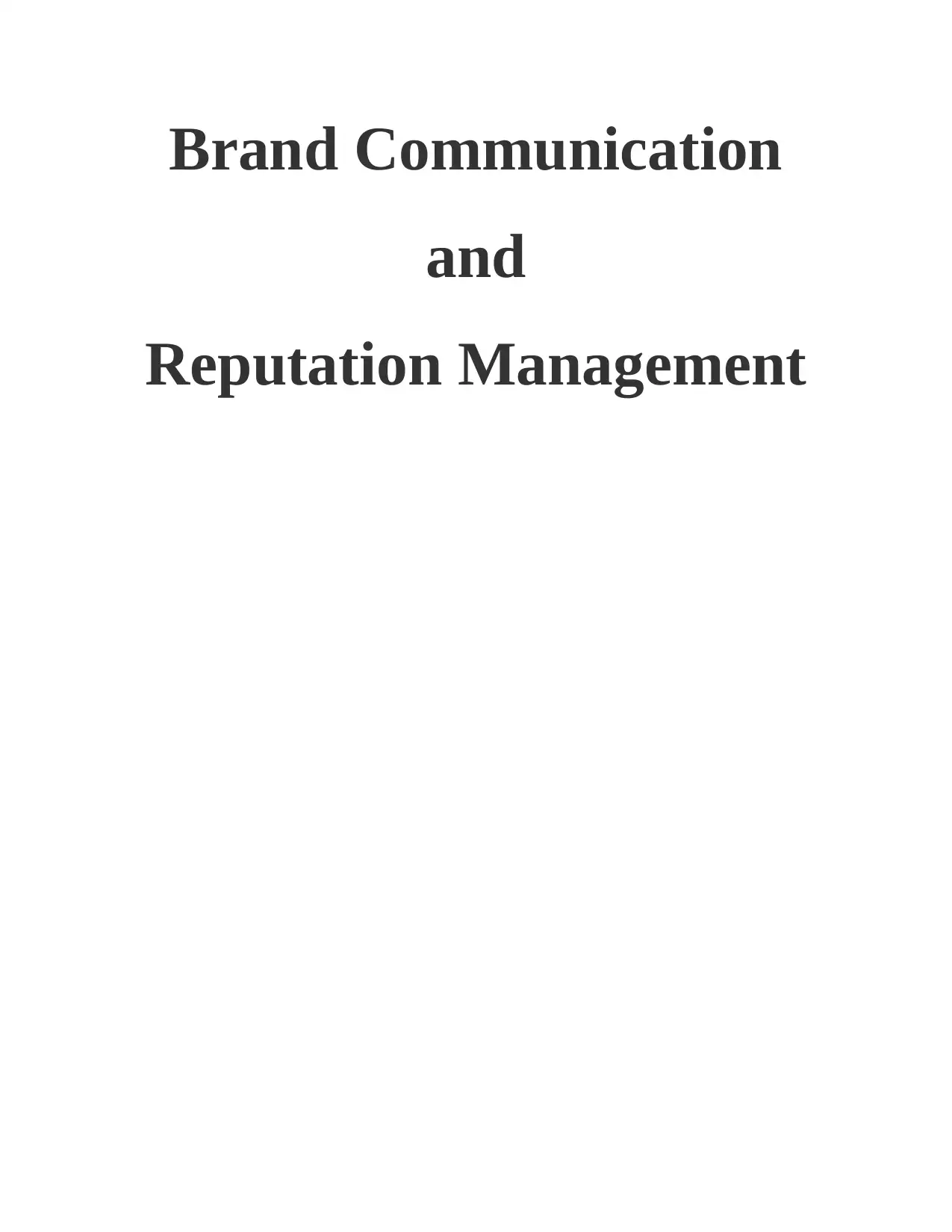
Brand Communication
and
Reputation Management
and
Reputation Management
Paraphrase This Document
Need a fresh take? Get an instant paraphrase of this document with our AI Paraphraser
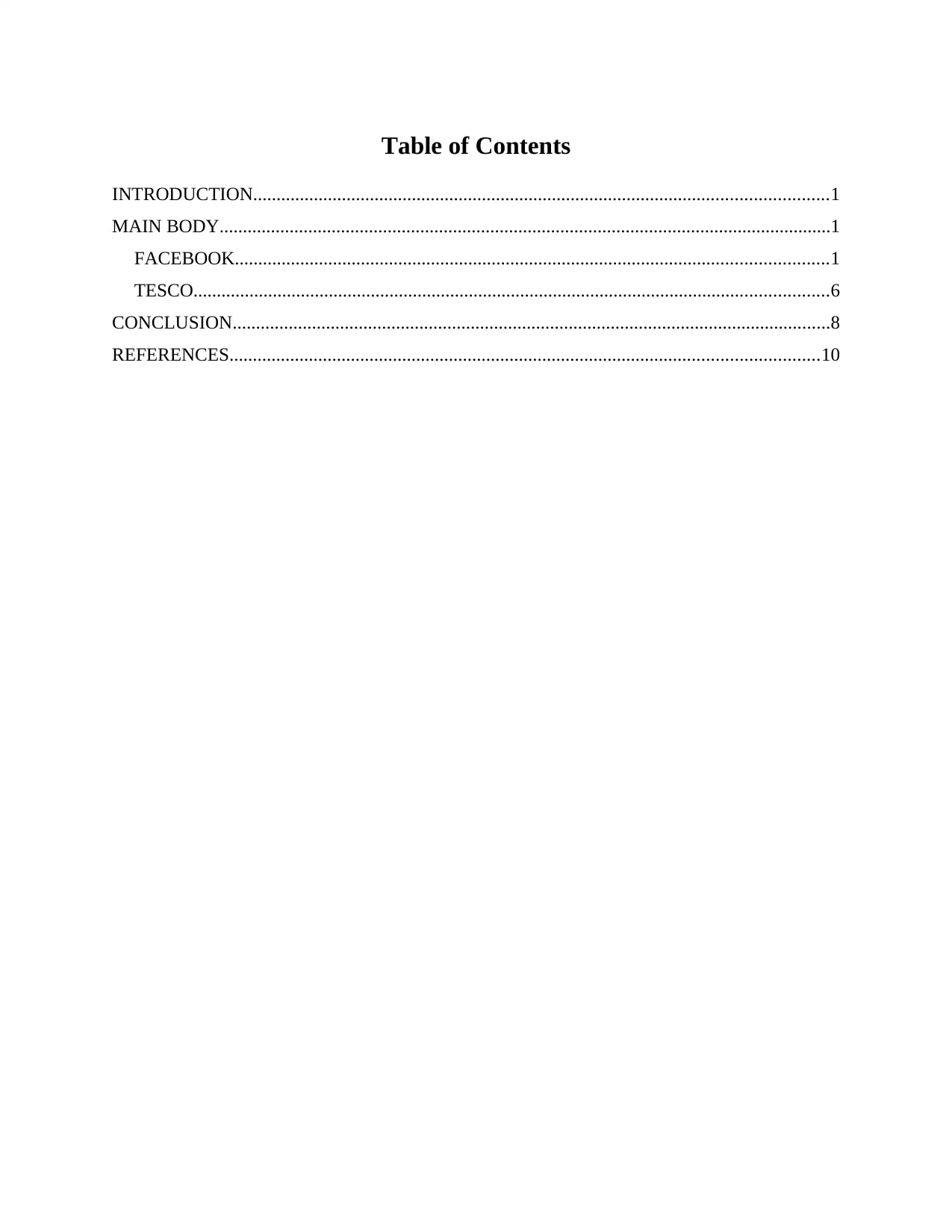
Table of Contents
INTRODUCTION...........................................................................................................................1
MAIN BODY...................................................................................................................................1
FACEBOOK...............................................................................................................................1
TESCO........................................................................................................................................6
CONCLUSION................................................................................................................................8
REFERENCES..............................................................................................................................10
INTRODUCTION...........................................................................................................................1
MAIN BODY...................................................................................................................................1
FACEBOOK...............................................................................................................................1
TESCO........................................................................................................................................6
CONCLUSION................................................................................................................................8
REFERENCES..............................................................................................................................10
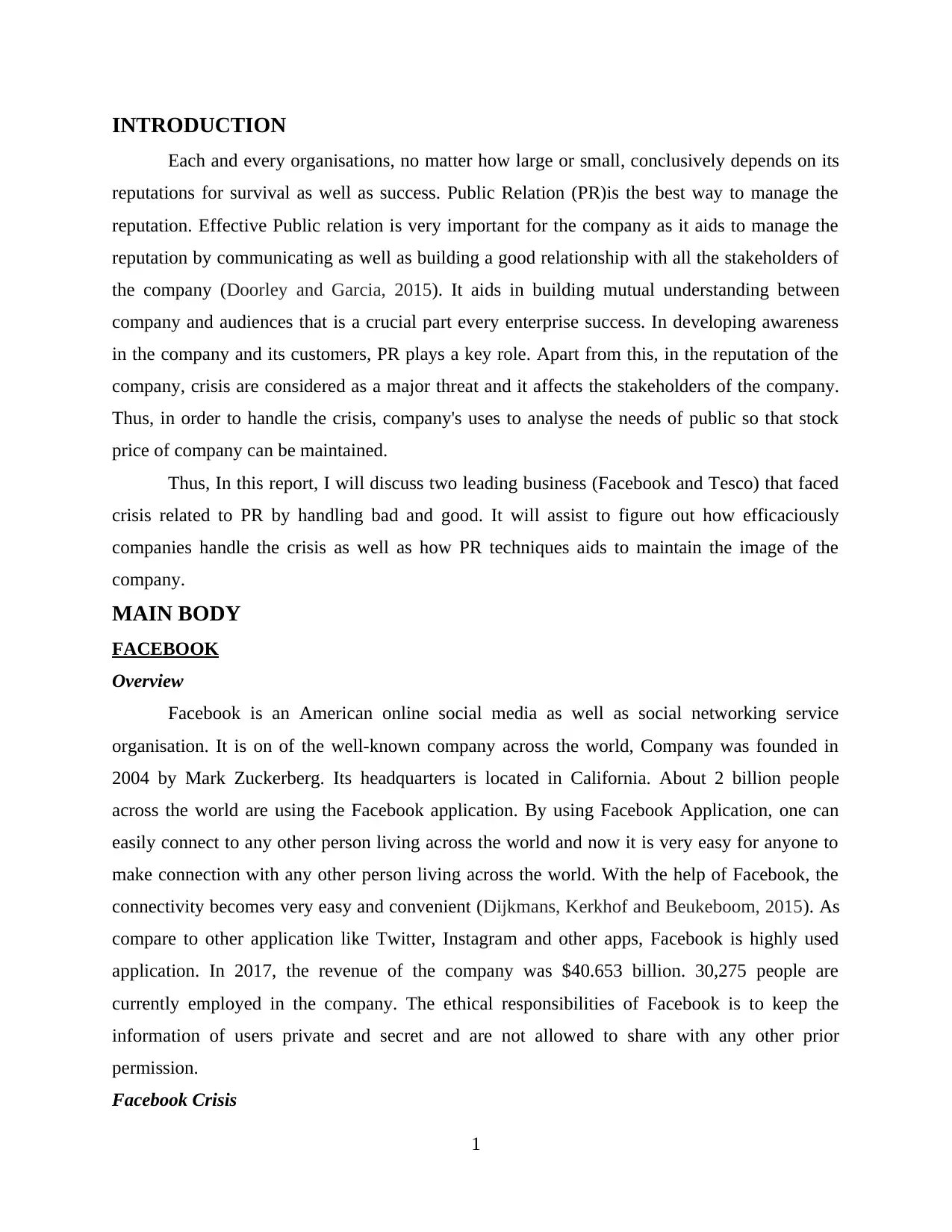
INTRODUCTION
Each and every organisations, no matter how large or small, conclusively depends on its
reputations for survival as well as success. Public Relation (PR)is the best way to manage the
reputation. Effective Public relation is very important for the company as it aids to manage the
reputation by communicating as well as building a good relationship with all the stakeholders of
the company (Doorley and Garcia, 2015). It aids in building mutual understanding between
company and audiences that is a crucial part every enterprise success. In developing awareness
in the company and its customers, PR plays a key role. Apart from this, in the reputation of the
company, crisis are considered as a major threat and it affects the stakeholders of the company.
Thus, in order to handle the crisis, company's uses to analyse the needs of public so that stock
price of company can be maintained.
Thus, In this report, I will discuss two leading business (Facebook and Tesco) that faced
crisis related to PR by handling bad and good. It will assist to figure out how efficaciously
companies handle the crisis as well as how PR techniques aids to maintain the image of the
company.
MAIN BODY
FACEBOOK
Overview
Facebook is an American online social media as well as social networking service
organisation. It is on of the well-known company across the world, Company was founded in
2004 by Mark Zuckerberg. Its headquarters is located in California. About 2 billion people
across the world are using the Facebook application. By using Facebook Application, one can
easily connect to any other person living across the world and now it is very easy for anyone to
make connection with any other person living across the world. With the help of Facebook, the
connectivity becomes very easy and convenient (Dijkmans, Kerkhof and Beukeboom, 2015). As
compare to other application like Twitter, Instagram and other apps, Facebook is highly used
application. In 2017, the revenue of the company was $40.653 billion. 30,275 people are
currently employed in the company. The ethical responsibilities of Facebook is to keep the
information of users private and secret and are not allowed to share with any other prior
permission.
Facebook Crisis
1
Each and every organisations, no matter how large or small, conclusively depends on its
reputations for survival as well as success. Public Relation (PR)is the best way to manage the
reputation. Effective Public relation is very important for the company as it aids to manage the
reputation by communicating as well as building a good relationship with all the stakeholders of
the company (Doorley and Garcia, 2015). It aids in building mutual understanding between
company and audiences that is a crucial part every enterprise success. In developing awareness
in the company and its customers, PR plays a key role. Apart from this, in the reputation of the
company, crisis are considered as a major threat and it affects the stakeholders of the company.
Thus, in order to handle the crisis, company's uses to analyse the needs of public so that stock
price of company can be maintained.
Thus, In this report, I will discuss two leading business (Facebook and Tesco) that faced
crisis related to PR by handling bad and good. It will assist to figure out how efficaciously
companies handle the crisis as well as how PR techniques aids to maintain the image of the
company.
MAIN BODY
Overview
Facebook is an American online social media as well as social networking service
organisation. It is on of the well-known company across the world, Company was founded in
2004 by Mark Zuckerberg. Its headquarters is located in California. About 2 billion people
across the world are using the Facebook application. By using Facebook Application, one can
easily connect to any other person living across the world and now it is very easy for anyone to
make connection with any other person living across the world. With the help of Facebook, the
connectivity becomes very easy and convenient (Dijkmans, Kerkhof and Beukeboom, 2015). As
compare to other application like Twitter, Instagram and other apps, Facebook is highly used
application. In 2017, the revenue of the company was $40.653 billion. 30,275 people are
currently employed in the company. The ethical responsibilities of Facebook is to keep the
information of users private and secret and are not allowed to share with any other prior
permission.
Facebook Crisis
1
⊘ This is a preview!⊘
Do you want full access?
Subscribe today to unlock all pages.

Trusted by 1+ million students worldwide
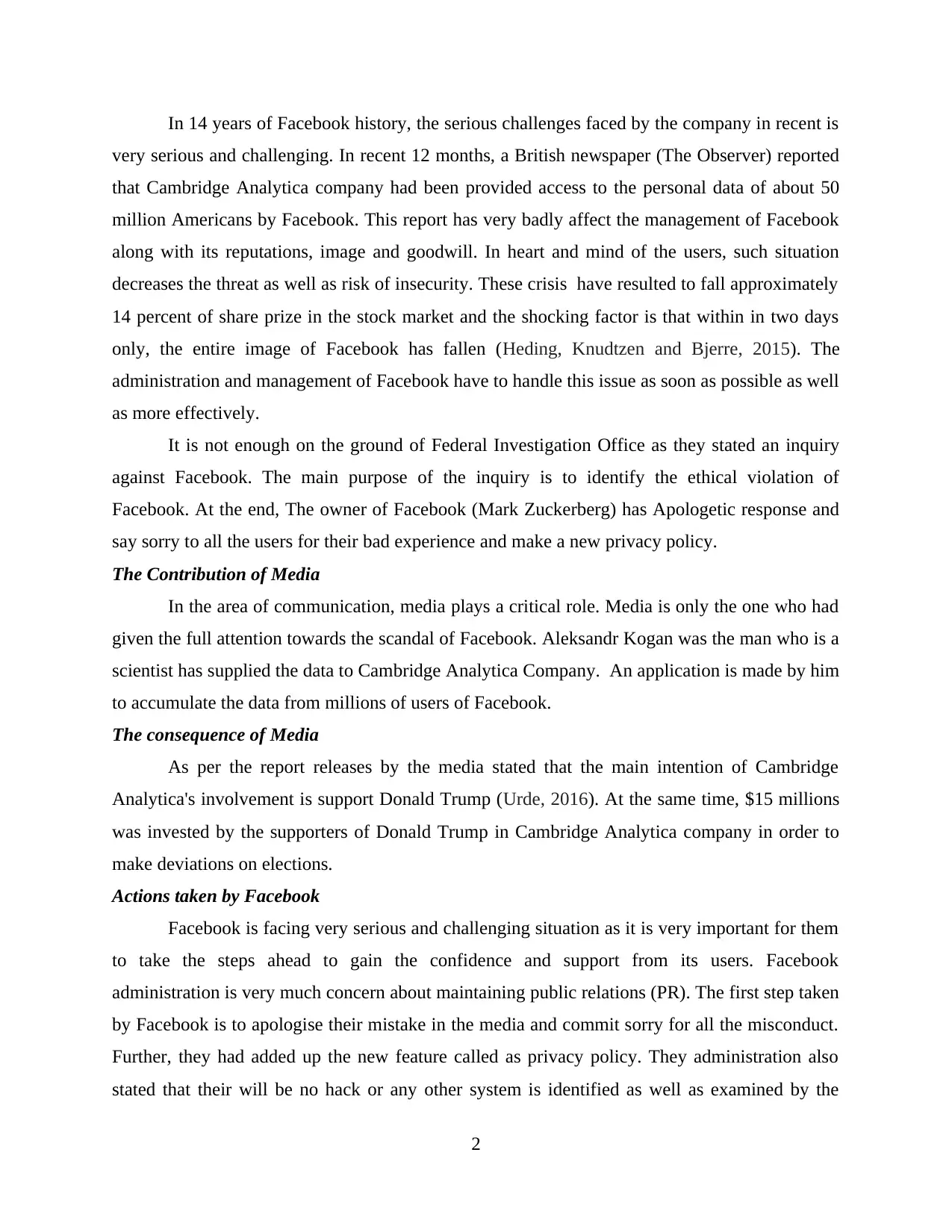
In 14 years of Facebook history, the serious challenges faced by the company in recent is
very serious and challenging. In recent 12 months, a British newspaper (The Observer) reported
that Cambridge Analytica company had been provided access to the personal data of about 50
million Americans by Facebook. This report has very badly affect the management of Facebook
along with its reputations, image and goodwill. In heart and mind of the users, such situation
decreases the threat as well as risk of insecurity. These crisis have resulted to fall approximately
14 percent of share prize in the stock market and the shocking factor is that within in two days
only, the entire image of Facebook has fallen (Heding, Knudtzen and Bjerre, 2015). The
administration and management of Facebook have to handle this issue as soon as possible as well
as more effectively.
It is not enough on the ground of Federal Investigation Office as they stated an inquiry
against Facebook. The main purpose of the inquiry is to identify the ethical violation of
Facebook. At the end, The owner of Facebook (Mark Zuckerberg) has Apologetic response and
say sorry to all the users for their bad experience and make a new privacy policy.
The Contribution of Media
In the area of communication, media plays a critical role. Media is only the one who had
given the full attention towards the scandal of Facebook. Aleksandr Kogan was the man who is a
scientist has supplied the data to Cambridge Analytica Company. An application is made by him
to accumulate the data from millions of users of Facebook.
The consequence of Media
As per the report releases by the media stated that the main intention of Cambridge
Analytica's involvement is support Donald Trump (Urde, 2016). At the same time, $15 millions
was invested by the supporters of Donald Trump in Cambridge Analytica company in order to
make deviations on elections.
Actions taken by Facebook
Facebook is facing very serious and challenging situation as it is very important for them
to take the steps ahead to gain the confidence and support from its users. Facebook
administration is very much concern about maintaining public relations (PR). The first step taken
by Facebook is to apologise their mistake in the media and commit sorry for all the misconduct.
Further, they had added up the new feature called as privacy policy. They administration also
stated that their will be no hack or any other system is identified as well as examined by the
2
very serious and challenging. In recent 12 months, a British newspaper (The Observer) reported
that Cambridge Analytica company had been provided access to the personal data of about 50
million Americans by Facebook. This report has very badly affect the management of Facebook
along with its reputations, image and goodwill. In heart and mind of the users, such situation
decreases the threat as well as risk of insecurity. These crisis have resulted to fall approximately
14 percent of share prize in the stock market and the shocking factor is that within in two days
only, the entire image of Facebook has fallen (Heding, Knudtzen and Bjerre, 2015). The
administration and management of Facebook have to handle this issue as soon as possible as well
as more effectively.
It is not enough on the ground of Federal Investigation Office as they stated an inquiry
against Facebook. The main purpose of the inquiry is to identify the ethical violation of
Facebook. At the end, The owner of Facebook (Mark Zuckerberg) has Apologetic response and
say sorry to all the users for their bad experience and make a new privacy policy.
The Contribution of Media
In the area of communication, media plays a critical role. Media is only the one who had
given the full attention towards the scandal of Facebook. Aleksandr Kogan was the man who is a
scientist has supplied the data to Cambridge Analytica Company. An application is made by him
to accumulate the data from millions of users of Facebook.
The consequence of Media
As per the report releases by the media stated that the main intention of Cambridge
Analytica's involvement is support Donald Trump (Urde, 2016). At the same time, $15 millions
was invested by the supporters of Donald Trump in Cambridge Analytica company in order to
make deviations on elections.
Actions taken by Facebook
Facebook is facing very serious and challenging situation as it is very important for them
to take the steps ahead to gain the confidence and support from its users. Facebook
administration is very much concern about maintaining public relations (PR). The first step taken
by Facebook is to apologise their mistake in the media and commit sorry for all the misconduct.
Further, they had added up the new feature called as privacy policy. They administration also
stated that their will be no hack or any other system is identified as well as examined by the
2
Paraphrase This Document
Need a fresh take? Get an instant paraphrase of this document with our AI Paraphraser
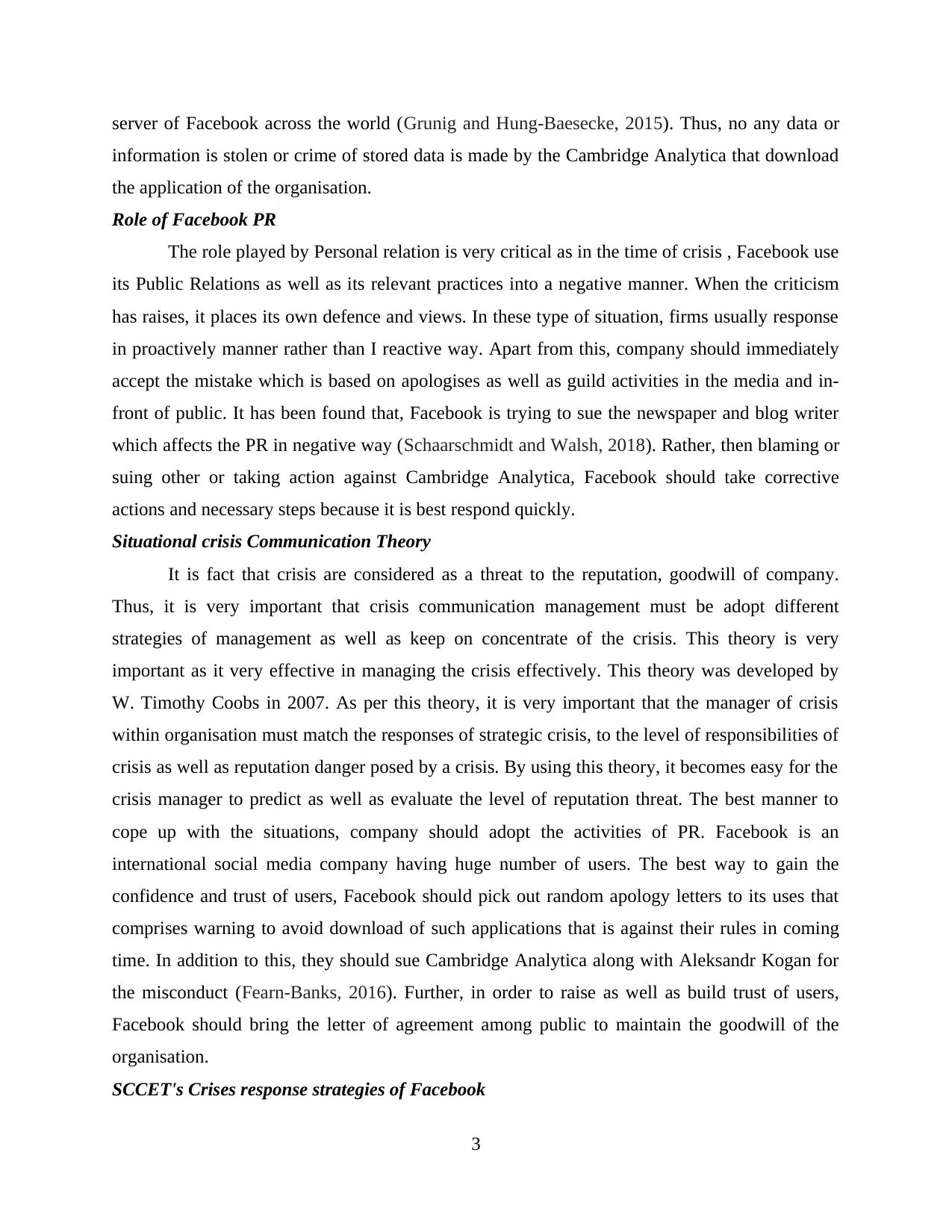
server of Facebook across the world (Grunig and Hung-Baesecke, 2015). Thus, no any data or
information is stolen or crime of stored data is made by the Cambridge Analytica that download
the application of the organisation.
Role of Facebook PR
The role played by Personal relation is very critical as in the time of crisis , Facebook use
its Public Relations as well as its relevant practices into a negative manner. When the criticism
has raises, it places its own defence and views. In these type of situation, firms usually response
in proactively manner rather than I reactive way. Apart from this, company should immediately
accept the mistake which is based on apologises as well as guild activities in the media and in-
front of public. It has been found that, Facebook is trying to sue the newspaper and blog writer
which affects the PR in negative way (Schaarschmidt and Walsh, 2018). Rather, then blaming or
suing other or taking action against Cambridge Analytica, Facebook should take corrective
actions and necessary steps because it is best respond quickly.
Situational crisis Communication Theory
It is fact that crisis are considered as a threat to the reputation, goodwill of company.
Thus, it is very important that crisis communication management must be adopt different
strategies of management as well as keep on concentrate of the crisis. This theory is very
important as it very effective in managing the crisis effectively. This theory was developed by
W. Timothy Coobs in 2007. As per this theory, it is very important that the manager of crisis
within organisation must match the responses of strategic crisis, to the level of responsibilities of
crisis as well as reputation danger posed by a crisis. By using this theory, it becomes easy for the
crisis manager to predict as well as evaluate the level of reputation threat. The best manner to
cope up with the situations, company should adopt the activities of PR. Facebook is an
international social media company having huge number of users. The best way to gain the
confidence and trust of users, Facebook should pick out random apology letters to its uses that
comprises warning to avoid download of such applications that is against their rules in coming
time. In addition to this, they should sue Cambridge Analytica along with Aleksandr Kogan for
the misconduct (Fearn-Banks, 2016). Further, in order to raise as well as build trust of users,
Facebook should bring the letter of agreement among public to maintain the goodwill of the
organisation.
SCCET's Crises response strategies of Facebook
3
information is stolen or crime of stored data is made by the Cambridge Analytica that download
the application of the organisation.
Role of Facebook PR
The role played by Personal relation is very critical as in the time of crisis , Facebook use
its Public Relations as well as its relevant practices into a negative manner. When the criticism
has raises, it places its own defence and views. In these type of situation, firms usually response
in proactively manner rather than I reactive way. Apart from this, company should immediately
accept the mistake which is based on apologises as well as guild activities in the media and in-
front of public. It has been found that, Facebook is trying to sue the newspaper and blog writer
which affects the PR in negative way (Schaarschmidt and Walsh, 2018). Rather, then blaming or
suing other or taking action against Cambridge Analytica, Facebook should take corrective
actions and necessary steps because it is best respond quickly.
Situational crisis Communication Theory
It is fact that crisis are considered as a threat to the reputation, goodwill of company.
Thus, it is very important that crisis communication management must be adopt different
strategies of management as well as keep on concentrate of the crisis. This theory is very
important as it very effective in managing the crisis effectively. This theory was developed by
W. Timothy Coobs in 2007. As per this theory, it is very important that the manager of crisis
within organisation must match the responses of strategic crisis, to the level of responsibilities of
crisis as well as reputation danger posed by a crisis. By using this theory, it becomes easy for the
crisis manager to predict as well as evaluate the level of reputation threat. The best manner to
cope up with the situations, company should adopt the activities of PR. Facebook is an
international social media company having huge number of users. The best way to gain the
confidence and trust of users, Facebook should pick out random apology letters to its uses that
comprises warning to avoid download of such applications that is against their rules in coming
time. In addition to this, they should sue Cambridge Analytica along with Aleksandr Kogan for
the misconduct (Fearn-Banks, 2016). Further, in order to raise as well as build trust of users,
Facebook should bring the letter of agreement among public to maintain the goodwill of the
organisation.
SCCET's Crises response strategies of Facebook
3
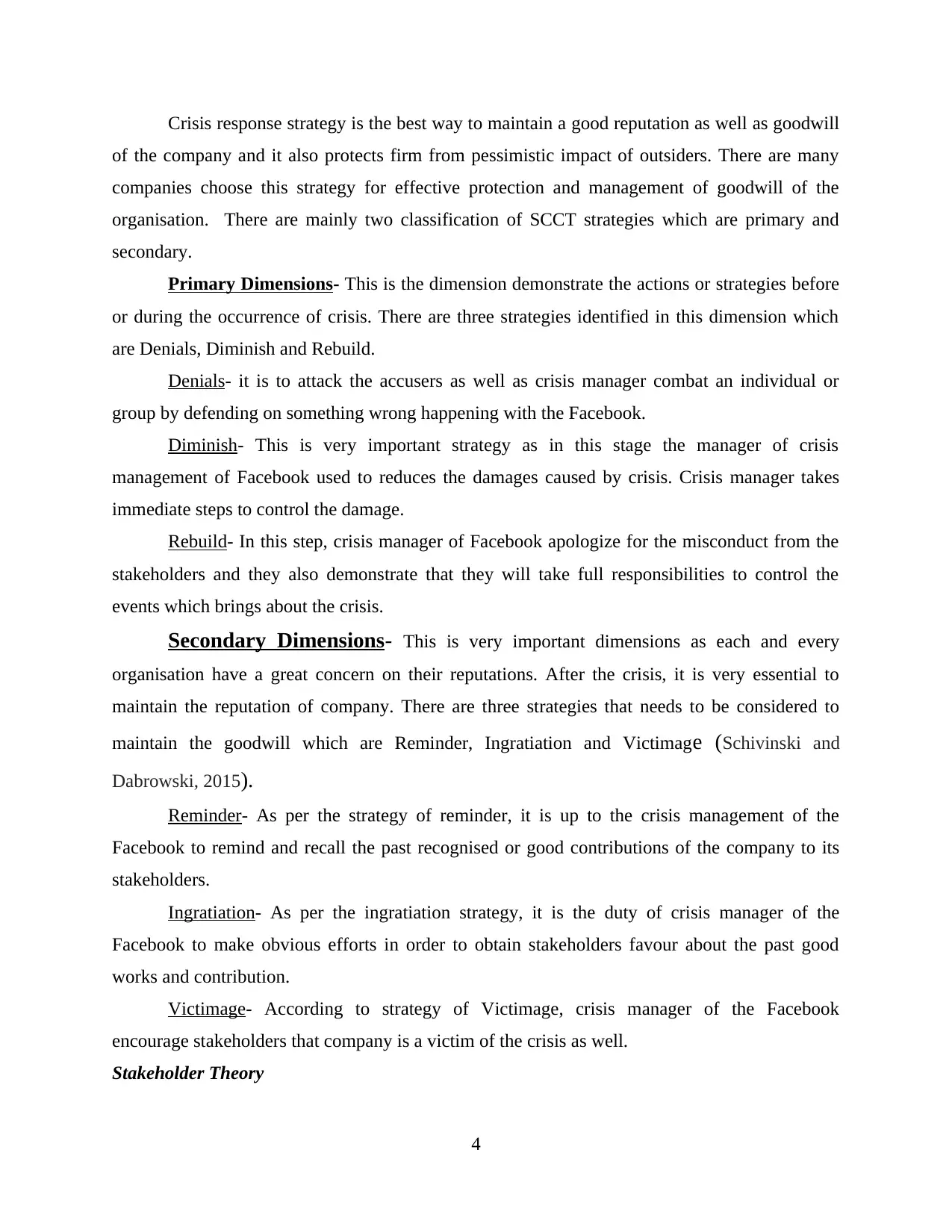
Crisis response strategy is the best way to maintain a good reputation as well as goodwill
of the company and it also protects firm from pessimistic impact of outsiders. There are many
companies choose this strategy for effective protection and management of goodwill of the
organisation. There are mainly two classification of SCCT strategies which are primary and
secondary.
Primary Dimensions- This is the dimension demonstrate the actions or strategies before
or during the occurrence of crisis. There are three strategies identified in this dimension which
are Denials, Diminish and Rebuild.
Denials- it is to attack the accusers as well as crisis manager combat an individual or
group by defending on something wrong happening with the Facebook.
Diminish- This is very important strategy as in this stage the manager of crisis
management of Facebook used to reduces the damages caused by crisis. Crisis manager takes
immediate steps to control the damage.
Rebuild- In this step, crisis manager of Facebook apologize for the misconduct from the
stakeholders and they also demonstrate that they will take full responsibilities to control the
events which brings about the crisis.
Secondary Dimensions- This is very important dimensions as each and every
organisation have a great concern on their reputations. After the crisis, it is very essential to
maintain the reputation of company. There are three strategies that needs to be considered to
maintain the goodwill which are Reminder, Ingratiation and Victimage (Schivinski and
Dabrowski, 2015).
Reminder- As per the strategy of reminder, it is up to the crisis management of the
Facebook to remind and recall the past recognised or good contributions of the company to its
stakeholders.
Ingratiation- As per the ingratiation strategy, it is the duty of crisis manager of the
Facebook to make obvious efforts in order to obtain stakeholders favour about the past good
works and contribution.
Victimage- According to strategy of Victimage, crisis manager of the Facebook
encourage stakeholders that company is a victim of the crisis as well.
Stakeholder Theory
4
of the company and it also protects firm from pessimistic impact of outsiders. There are many
companies choose this strategy for effective protection and management of goodwill of the
organisation. There are mainly two classification of SCCT strategies which are primary and
secondary.
Primary Dimensions- This is the dimension demonstrate the actions or strategies before
or during the occurrence of crisis. There are three strategies identified in this dimension which
are Denials, Diminish and Rebuild.
Denials- it is to attack the accusers as well as crisis manager combat an individual or
group by defending on something wrong happening with the Facebook.
Diminish- This is very important strategy as in this stage the manager of crisis
management of Facebook used to reduces the damages caused by crisis. Crisis manager takes
immediate steps to control the damage.
Rebuild- In this step, crisis manager of Facebook apologize for the misconduct from the
stakeholders and they also demonstrate that they will take full responsibilities to control the
events which brings about the crisis.
Secondary Dimensions- This is very important dimensions as each and every
organisation have a great concern on their reputations. After the crisis, it is very essential to
maintain the reputation of company. There are three strategies that needs to be considered to
maintain the goodwill which are Reminder, Ingratiation and Victimage (Schivinski and
Dabrowski, 2015).
Reminder- As per the strategy of reminder, it is up to the crisis management of the
Facebook to remind and recall the past recognised or good contributions of the company to its
stakeholders.
Ingratiation- As per the ingratiation strategy, it is the duty of crisis manager of the
Facebook to make obvious efforts in order to obtain stakeholders favour about the past good
works and contribution.
Victimage- According to strategy of Victimage, crisis manager of the Facebook
encourage stakeholders that company is a victim of the crisis as well.
Stakeholder Theory
4
⊘ This is a preview!⊘
Do you want full access?
Subscribe today to unlock all pages.

Trusted by 1+ million students worldwide
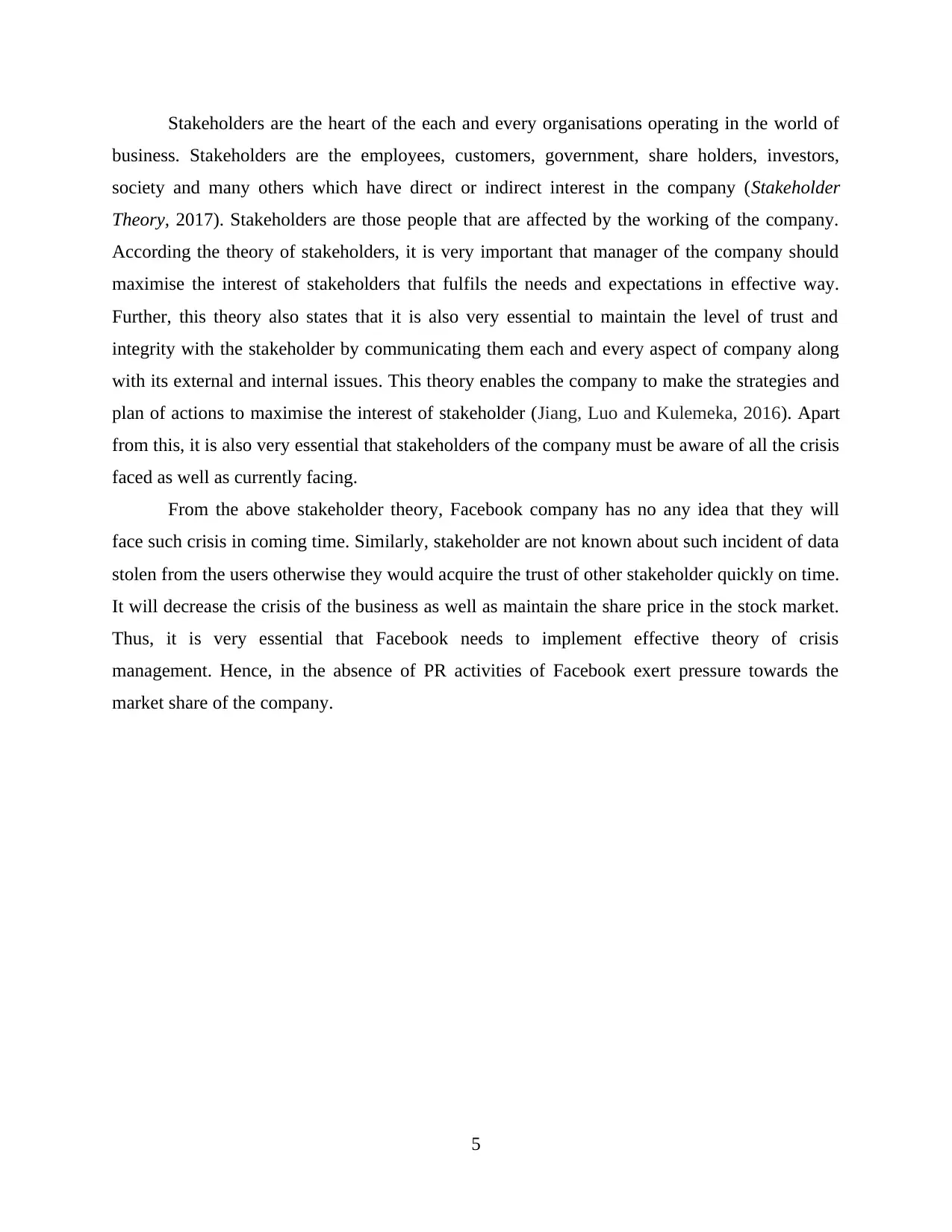
Stakeholders are the heart of the each and every organisations operating in the world of
business. Stakeholders are the employees, customers, government, share holders, investors,
society and many others which have direct or indirect interest in the company (Stakeholder
Theory, 2017). Stakeholders are those people that are affected by the working of the company.
According the theory of stakeholders, it is very important that manager of the company should
maximise the interest of stakeholders that fulfils the needs and expectations in effective way.
Further, this theory also states that it is also very essential to maintain the level of trust and
integrity with the stakeholder by communicating them each and every aspect of company along
with its external and internal issues. This theory enables the company to make the strategies and
plan of actions to maximise the interest of stakeholder (Jiang, Luo and Kulemeka, 2016). Apart
from this, it is also very essential that stakeholders of the company must be aware of all the crisis
faced as well as currently facing.
From the above stakeholder theory, Facebook company has no any idea that they will
face such crisis in coming time. Similarly, stakeholder are not known about such incident of data
stolen from the users otherwise they would acquire the trust of other stakeholder quickly on time.
It will decrease the crisis of the business as well as maintain the share price in the stock market.
Thus, it is very essential that Facebook needs to implement effective theory of crisis
management. Hence, in the absence of PR activities of Facebook exert pressure towards the
market share of the company.
5
business. Stakeholders are the employees, customers, government, share holders, investors,
society and many others which have direct or indirect interest in the company (Stakeholder
Theory, 2017). Stakeholders are those people that are affected by the working of the company.
According the theory of stakeholders, it is very important that manager of the company should
maximise the interest of stakeholders that fulfils the needs and expectations in effective way.
Further, this theory also states that it is also very essential to maintain the level of trust and
integrity with the stakeholder by communicating them each and every aspect of company along
with its external and internal issues. This theory enables the company to make the strategies and
plan of actions to maximise the interest of stakeholder (Jiang, Luo and Kulemeka, 2016). Apart
from this, it is also very essential that stakeholders of the company must be aware of all the crisis
faced as well as currently facing.
From the above stakeholder theory, Facebook company has no any idea that they will
face such crisis in coming time. Similarly, stakeholder are not known about such incident of data
stolen from the users otherwise they would acquire the trust of other stakeholder quickly on time.
It will decrease the crisis of the business as well as maintain the share price in the stock market.
Thus, it is very essential that Facebook needs to implement effective theory of crisis
management. Hence, in the absence of PR activities of Facebook exert pressure towards the
market share of the company.
5
Paraphrase This Document
Need a fresh take? Get an instant paraphrase of this document with our AI Paraphraser
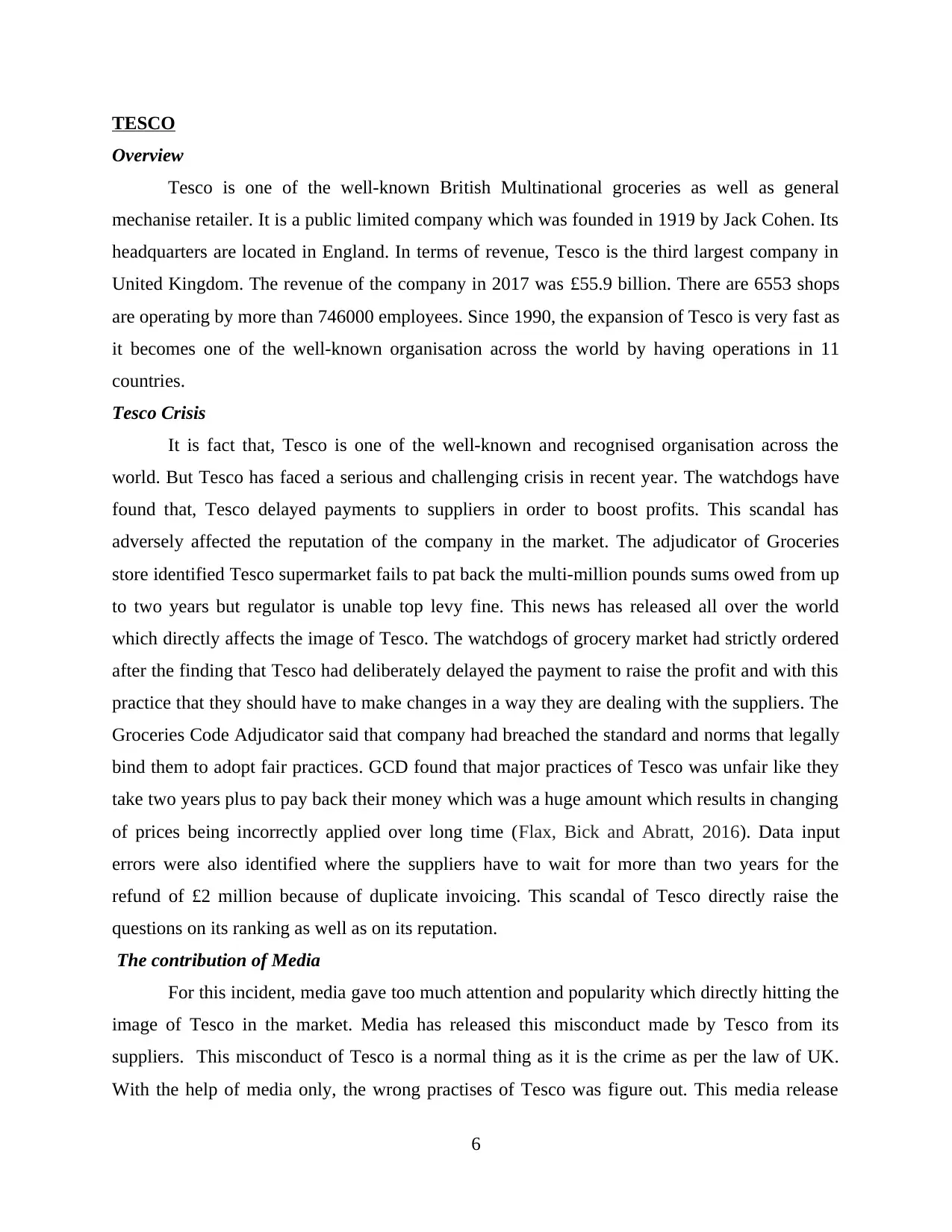
TESCO
Overview
Tesco is one of the well-known British Multinational groceries as well as general
mechanise retailer. It is a public limited company which was founded in 1919 by Jack Cohen. Its
headquarters are located in England. In terms of revenue, Tesco is the third largest company in
United Kingdom. The revenue of the company in 2017 was £55.9 billion. There are 6553 shops
are operating by more than 746000 employees. Since 1990, the expansion of Tesco is very fast as
it becomes one of the well-known organisation across the world by having operations in 11
countries.
Tesco Crisis
It is fact that, Tesco is one of the well-known and recognised organisation across the
world. But Tesco has faced a serious and challenging crisis in recent year. The watchdogs have
found that, Tesco delayed payments to suppliers in order to boost profits. This scandal has
adversely affected the reputation of the company in the market. The adjudicator of Groceries
store identified Tesco supermarket fails to pat back the multi-million pounds sums owed from up
to two years but regulator is unable top levy fine. This news has released all over the world
which directly affects the image of Tesco. The watchdogs of grocery market had strictly ordered
after the finding that Tesco had deliberately delayed the payment to raise the profit and with this
practice that they should have to make changes in a way they are dealing with the suppliers. The
Groceries Code Adjudicator said that company had breached the standard and norms that legally
bind them to adopt fair practices. GCD found that major practices of Tesco was unfair like they
take two years plus to pay back their money which was a huge amount which results in changing
of prices being incorrectly applied over long time (Flax, Bick and Abratt, 2016). Data input
errors were also identified where the suppliers have to wait for more than two years for the
refund of £2 million because of duplicate invoicing. This scandal of Tesco directly raise the
questions on its ranking as well as on its reputation.
The contribution of Media
For this incident, media gave too much attention and popularity which directly hitting the
image of Tesco in the market. Media has released this misconduct made by Tesco from its
suppliers. This misconduct of Tesco is a normal thing as it is the crime as per the law of UK.
With the help of media only, the wrong practises of Tesco was figure out. This media release
6
Overview
Tesco is one of the well-known British Multinational groceries as well as general
mechanise retailer. It is a public limited company which was founded in 1919 by Jack Cohen. Its
headquarters are located in England. In terms of revenue, Tesco is the third largest company in
United Kingdom. The revenue of the company in 2017 was £55.9 billion. There are 6553 shops
are operating by more than 746000 employees. Since 1990, the expansion of Tesco is very fast as
it becomes one of the well-known organisation across the world by having operations in 11
countries.
Tesco Crisis
It is fact that, Tesco is one of the well-known and recognised organisation across the
world. But Tesco has faced a serious and challenging crisis in recent year. The watchdogs have
found that, Tesco delayed payments to suppliers in order to boost profits. This scandal has
adversely affected the reputation of the company in the market. The adjudicator of Groceries
store identified Tesco supermarket fails to pat back the multi-million pounds sums owed from up
to two years but regulator is unable top levy fine. This news has released all over the world
which directly affects the image of Tesco. The watchdogs of grocery market had strictly ordered
after the finding that Tesco had deliberately delayed the payment to raise the profit and with this
practice that they should have to make changes in a way they are dealing with the suppliers. The
Groceries Code Adjudicator said that company had breached the standard and norms that legally
bind them to adopt fair practices. GCD found that major practices of Tesco was unfair like they
take two years plus to pay back their money which was a huge amount which results in changing
of prices being incorrectly applied over long time (Flax, Bick and Abratt, 2016). Data input
errors were also identified where the suppliers have to wait for more than two years for the
refund of £2 million because of duplicate invoicing. This scandal of Tesco directly raise the
questions on its ranking as well as on its reputation.
The contribution of Media
For this incident, media gave too much attention and popularity which directly hitting the
image of Tesco in the market. Media has released this misconduct made by Tesco from its
suppliers. This misconduct of Tesco is a normal thing as it is the crime as per the law of UK.
With the help of media only, the wrong practises of Tesco was figure out. This media release
6

report is not only to make a fall of Tesco but it is lesson for all other supermarkets that this
practise is totally illegal and it badly hit the image of company (Doorley and Garcia, 2015). On
the other hand, Tesco also apologises for the misconduct in the media and make promise to
audience that this practices would be stop and never be conducted again. In order to build the
image, Tesco has taken the help of media. Thus, the role played by media in the scandal of Tesco
was incredible for the both side.
Crisis Response Strategy of Tesco
This is one of the best strategy that is used by Tesco to build ore reconstruct the image or
reputation in the market. With the implementation of this strategy, the negative impact of scandal
on the reputation of company was bought down. There are two dimension of Crisis Response
strategy which are Primary and Secondary. These dimensions are studies and used by the crisis
manager during, after and before the crisis.
Primary Crisis Response Strategy
Deny Incident- it is to attack the accusers as well as crisis manager combat an individual
or group by defending on something wrong happening with the Tesco.
Diminish- The crisis manager of Tesco put their efforts to minimise the damage caused
by the scandal on the reputation of the company (Hewett and et.al., 2016).
Rebuild- At this stage, Crisis manager of Tesco used to apologise and make efforts to
build the truest relationship with the customers.
Secondary Crisis Response Strategy
Reminder- According to this stage, crisis manager of Tesco remind the past good words
of Tesco such as environmental contribution, employment generation, health and safety
contribution to the stakeholders in order to heal the damage caused by the scandal.
Ingratiation- According to ingratiation strategy, it is the responsibility of crisis manager
of Tesco to make apparent efforts to obtain stakeholders favour about the past good works and
contribution.
Situational Crisis Communication Theory
As per the words of Coombs (founder of the SCCT theory), the fundamental intention is
to offer a scheme for understanding how crisis manager can use this theory to defend the
company's reputation during the crisis. It is very important that company should protect their
stakeholder rather than worrying about the image or goodwill of the company because
7
practise is totally illegal and it badly hit the image of company (Doorley and Garcia, 2015). On
the other hand, Tesco also apologises for the misconduct in the media and make promise to
audience that this practices would be stop and never be conducted again. In order to build the
image, Tesco has taken the help of media. Thus, the role played by media in the scandal of Tesco
was incredible for the both side.
Crisis Response Strategy of Tesco
This is one of the best strategy that is used by Tesco to build ore reconstruct the image or
reputation in the market. With the implementation of this strategy, the negative impact of scandal
on the reputation of company was bought down. There are two dimension of Crisis Response
strategy which are Primary and Secondary. These dimensions are studies and used by the crisis
manager during, after and before the crisis.
Primary Crisis Response Strategy
Deny Incident- it is to attack the accusers as well as crisis manager combat an individual
or group by defending on something wrong happening with the Tesco.
Diminish- The crisis manager of Tesco put their efforts to minimise the damage caused
by the scandal on the reputation of the company (Hewett and et.al., 2016).
Rebuild- At this stage, Crisis manager of Tesco used to apologise and make efforts to
build the truest relationship with the customers.
Secondary Crisis Response Strategy
Reminder- According to this stage, crisis manager of Tesco remind the past good words
of Tesco such as environmental contribution, employment generation, health and safety
contribution to the stakeholders in order to heal the damage caused by the scandal.
Ingratiation- According to ingratiation strategy, it is the responsibility of crisis manager
of Tesco to make apparent efforts to obtain stakeholders favour about the past good works and
contribution.
Situational Crisis Communication Theory
As per the words of Coombs (founder of the SCCT theory), the fundamental intention is
to offer a scheme for understanding how crisis manager can use this theory to defend the
company's reputation during the crisis. It is very important that company should protect their
stakeholder rather than worrying about the image or goodwill of the company because
7
⊘ This is a preview!⊘
Do you want full access?
Subscribe today to unlock all pages.

Trusted by 1+ million students worldwide

stakeholder are like oxygen for the company to survive. There are three types of crisis which are
Victim crises (caused by natural disaster), Circumstance crisis (not in hand, circumstances may
cause) and preventable crises (caused by human errors) (Buil, Martínez and Matute, 2016). Thus,
Tesco has faced preventable crisis and it is one of the dangerous crises as compare to others
because it directly hit the image of the company.
Crisis Management Theory
Crisis management theory is also very essential that organisation used in order to analyse
the level of crisis faced by the company as well as it how it influenced the business reputations.
The crisis faced by Tesco is very big as it directly hit the reputation of company among its
stakeholders. It is the duty and responsibilities of crisis manager to take immediate actions to
resolve or overcome the impact of crisis (Crisis Management Theory, 2017). The best way to
overcome the threat is to send the apology message or letter via social media, newspaper, email
etc. to stakeholders. The PR action of Tesco in order to retain the generously as well as
reputation holds by the business in the applicable sector.
Stakeholder Theory
Stakeholders are the key to achieve success in the market and it is fact. It is vital for all
the organisations to implement or use stakeholder theory as it is very essential that company
should create value to stakeholder not only for shareholders. Company should have to behave
fairly and equally with all its stakeholders. According to this theory, company should have to
take steps to maximise the interest of stakeholders because they are only the people who can save
the business from the exit. Thus, Tesco should also send message of apology and commit sorry
to all its stakeholders so that they feel a little sympathy for the company and give one more
chance to more on. The primary purpose of using this theory to make the stakeholders always
inform about what is happening in the company and by what stage they are passing through
(Dutot, Lacalle Galvez and Versailles, 2016). For Tesco, this strategy directly helps them, to
build trust and worthy relationship with the stakeholder.
CONCLUSION
The above report concluded that impact of risk factors in the businesses as well as the
importance of reputation of the company in the market. It is fact that, in the world of business, no
one knows what will happen next to them, thus, it is very important that company's should be
aware of the crisis that they have to face in the future. The above study makes it crystal clear that
8
Victim crises (caused by natural disaster), Circumstance crisis (not in hand, circumstances may
cause) and preventable crises (caused by human errors) (Buil, Martínez and Matute, 2016). Thus,
Tesco has faced preventable crisis and it is one of the dangerous crises as compare to others
because it directly hit the image of the company.
Crisis Management Theory
Crisis management theory is also very essential that organisation used in order to analyse
the level of crisis faced by the company as well as it how it influenced the business reputations.
The crisis faced by Tesco is very big as it directly hit the reputation of company among its
stakeholders. It is the duty and responsibilities of crisis manager to take immediate actions to
resolve or overcome the impact of crisis (Crisis Management Theory, 2017). The best way to
overcome the threat is to send the apology message or letter via social media, newspaper, email
etc. to stakeholders. The PR action of Tesco in order to retain the generously as well as
reputation holds by the business in the applicable sector.
Stakeholder Theory
Stakeholders are the key to achieve success in the market and it is fact. It is vital for all
the organisations to implement or use stakeholder theory as it is very essential that company
should create value to stakeholder not only for shareholders. Company should have to behave
fairly and equally with all its stakeholders. According to this theory, company should have to
take steps to maximise the interest of stakeholders because they are only the people who can save
the business from the exit. Thus, Tesco should also send message of apology and commit sorry
to all its stakeholders so that they feel a little sympathy for the company and give one more
chance to more on. The primary purpose of using this theory to make the stakeholders always
inform about what is happening in the company and by what stage they are passing through
(Dutot, Lacalle Galvez and Versailles, 2016). For Tesco, this strategy directly helps them, to
build trust and worthy relationship with the stakeholder.
CONCLUSION
The above report concluded that impact of risk factors in the businesses as well as the
importance of reputation of the company in the market. It is fact that, in the world of business, no
one knows what will happen next to them, thus, it is very important that company's should be
aware of the crisis that they have to face in the future. The above study makes it crystal clear that
8
Paraphrase This Document
Need a fresh take? Get an instant paraphrase of this document with our AI Paraphraser

crisis is the part of organisation operations activities. Further, the importance of PR to overcome
the threat was also discussed which is the best way to build and re-construct the reputation of the
company. The PR techniques helps both Facebook and Tesco to maintain their reputation after
the scandal in effective manner if PR techniques fails than company have to suffer the huge loss.
9
the threat was also discussed which is the best way to build and re-construct the reputation of the
company. The PR techniques helps both Facebook and Tesco to maintain their reputation after
the scandal in effective manner if PR techniques fails than company have to suffer the huge loss.
9
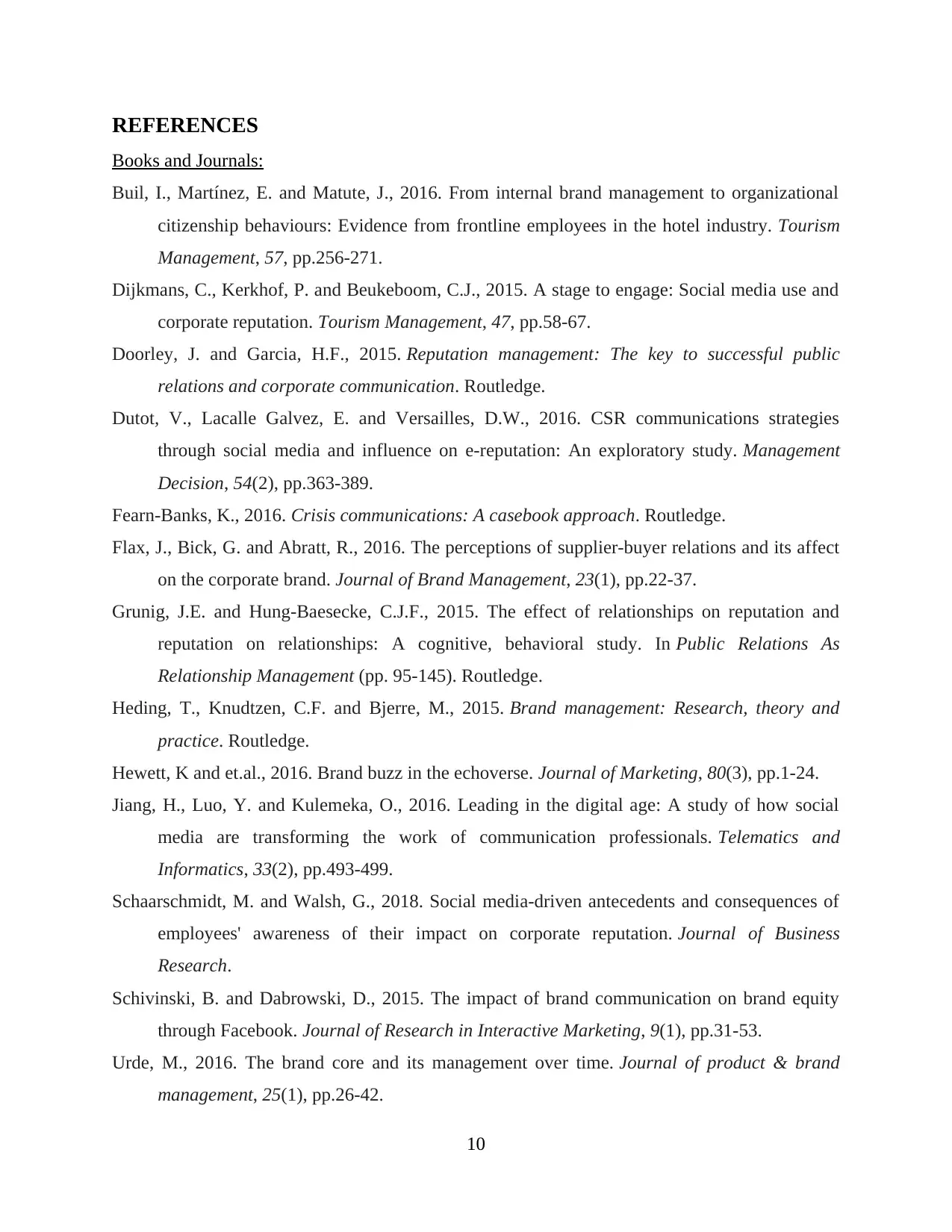
REFERENCES
Books and Journals:
Buil, I., Martínez, E. and Matute, J., 2016. From internal brand management to organizational
citizenship behaviours: Evidence from frontline employees in the hotel industry. Tourism
Management, 57, pp.256-271.
Dijkmans, C., Kerkhof, P. and Beukeboom, C.J., 2015. A stage to engage: Social media use and
corporate reputation. Tourism Management, 47, pp.58-67.
Doorley, J. and Garcia, H.F., 2015. Reputation management: The key to successful public
relations and corporate communication. Routledge.
Dutot, V., Lacalle Galvez, E. and Versailles, D.W., 2016. CSR communications strategies
through social media and influence on e-reputation: An exploratory study. Management
Decision, 54(2), pp.363-389.
Fearn-Banks, K., 2016. Crisis communications: A casebook approach. Routledge.
Flax, J., Bick, G. and Abratt, R., 2016. The perceptions of supplier-buyer relations and its affect
on the corporate brand. Journal of Brand Management, 23(1), pp.22-37.
Grunig, J.E. and Hung-Baesecke, C.J.F., 2015. The effect of relationships on reputation and
reputation on relationships: A cognitive, behavioral study. In Public Relations As
Relationship Management (pp. 95-145). Routledge.
Heding, T., Knudtzen, C.F. and Bjerre, M., 2015. Brand management: Research, theory and
practice. Routledge.
Hewett, K and et.al., 2016. Brand buzz in the echoverse. Journal of Marketing, 80(3), pp.1-24.
Jiang, H., Luo, Y. and Kulemeka, O., 2016. Leading in the digital age: A study of how social
media are transforming the work of communication professionals. Telematics and
Informatics, 33(2), pp.493-499.
Schaarschmidt, M. and Walsh, G., 2018. Social media-driven antecedents and consequences of
employees' awareness of their impact on corporate reputation. Journal of Business
Research.
Schivinski, B. and Dabrowski, D., 2015. The impact of brand communication on brand equity
through Facebook. Journal of Research in Interactive Marketing, 9(1), pp.31-53.
Urde, M., 2016. The brand core and its management over time. Journal of product & brand
management, 25(1), pp.26-42.
10
Books and Journals:
Buil, I., Martínez, E. and Matute, J., 2016. From internal brand management to organizational
citizenship behaviours: Evidence from frontline employees in the hotel industry. Tourism
Management, 57, pp.256-271.
Dijkmans, C., Kerkhof, P. and Beukeboom, C.J., 2015. A stage to engage: Social media use and
corporate reputation. Tourism Management, 47, pp.58-67.
Doorley, J. and Garcia, H.F., 2015. Reputation management: The key to successful public
relations and corporate communication. Routledge.
Dutot, V., Lacalle Galvez, E. and Versailles, D.W., 2016. CSR communications strategies
through social media and influence on e-reputation: An exploratory study. Management
Decision, 54(2), pp.363-389.
Fearn-Banks, K., 2016. Crisis communications: A casebook approach. Routledge.
Flax, J., Bick, G. and Abratt, R., 2016. The perceptions of supplier-buyer relations and its affect
on the corporate brand. Journal of Brand Management, 23(1), pp.22-37.
Grunig, J.E. and Hung-Baesecke, C.J.F., 2015. The effect of relationships on reputation and
reputation on relationships: A cognitive, behavioral study. In Public Relations As
Relationship Management (pp. 95-145). Routledge.
Heding, T., Knudtzen, C.F. and Bjerre, M., 2015. Brand management: Research, theory and
practice. Routledge.
Hewett, K and et.al., 2016. Brand buzz in the echoverse. Journal of Marketing, 80(3), pp.1-24.
Jiang, H., Luo, Y. and Kulemeka, O., 2016. Leading in the digital age: A study of how social
media are transforming the work of communication professionals. Telematics and
Informatics, 33(2), pp.493-499.
Schaarschmidt, M. and Walsh, G., 2018. Social media-driven antecedents and consequences of
employees' awareness of their impact on corporate reputation. Journal of Business
Research.
Schivinski, B. and Dabrowski, D., 2015. The impact of brand communication on brand equity
through Facebook. Journal of Research in Interactive Marketing, 9(1), pp.31-53.
Urde, M., 2016. The brand core and its management over time. Journal of product & brand
management, 25(1), pp.26-42.
10
⊘ This is a preview!⊘
Do you want full access?
Subscribe today to unlock all pages.

Trusted by 1+ million students worldwide
1 out of 14
Related Documents
Your All-in-One AI-Powered Toolkit for Academic Success.
+13062052269
info@desklib.com
Available 24*7 on WhatsApp / Email
![[object Object]](/_next/static/media/star-bottom.7253800d.svg)
Unlock your academic potential
Copyright © 2020–2025 A2Z Services. All Rights Reserved. Developed and managed by ZUCOL.





